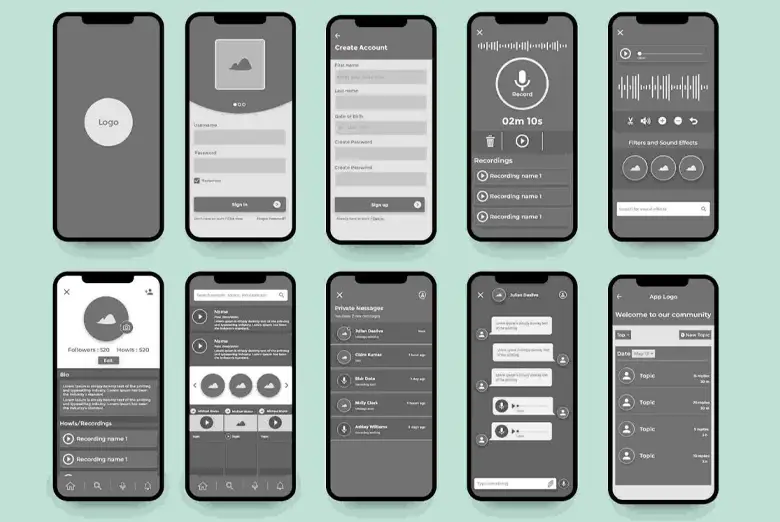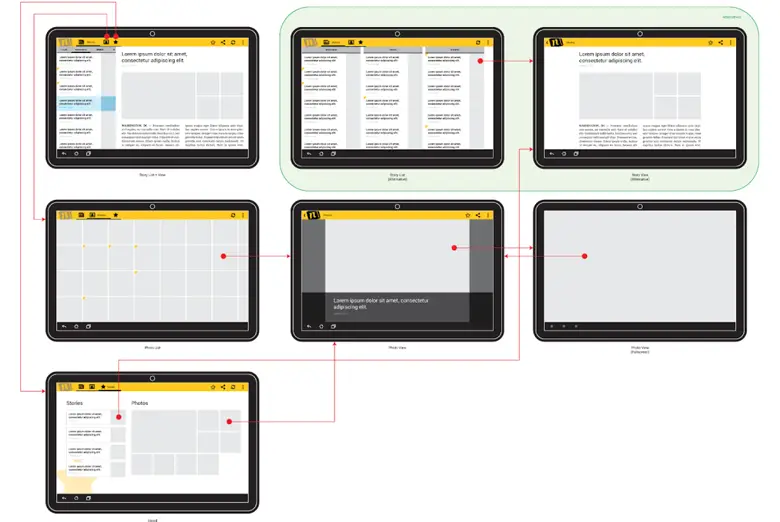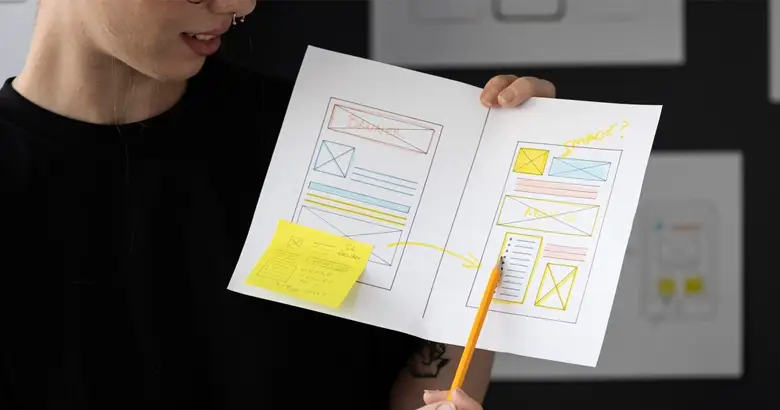Learn everything about high-fidelity wireframes, from understanding how they differ from their low-fidelity counterparts to their pros and cons. Additionally, find out how to create such wireframes and the best templates and tools to use.
High-fidelity wireframes are tools that help you design detailed interfaces. These wireframes focus on the prototype’s functionality, aesthetics, and workflow, offering a clear preview of the end product.
In this comprehensive guide, we will explain the purpose of high-fidelity wireframes, their benefits and limitations, and discuss the differences between low-fidelity and high-fidelity wireframes. We will also walk you through the essential steps to create such a wireframe, explore the best templates and tools, and answer frequently asked questions.
Contents:
- What Is a High-Fidelity Wireframe?
- What Is the Purpose of a High-Fidelity Wireframe?
- Difference Between High-Fidelity and Low-Fidelity Wireframes
- Benefits of High-Fidelity Wireframes
- Limitations of High-Fidelity Wireframes
- Step-By-Step Process of Creating a High-Fidelity Wireframe
- High-Fidelity Wireframe Templates
- High-Fidelity Wireframe Tools
- FAQs
- Conclusion
What Is a High-Fidelity Wireframe?
A high-fidelity wireframe is a detailed representation of a design interface that communicates your idea with more clarity. It shows all the elements on the screen, including what the user will see when scanning the page, and helps you put across visuals that your team members and clients will find easy to comprehend. Unlike low or mid-fidelity wireframes, high-fidelity wireframes offer a precise understanding of the look and feel of the website or app. Designers use high-fidelity wireframes to give a compelling design overview, making them an essential tool in the UI UX design process. Here are a few reasons why designers prefer high-fidelity wireframes:
Enhanced Clarity – Visual elements like colors, images, and typography accurately represent a clear and precise vision of the final design.
Realistic Previews – High-fidelity wireframes create realistic previews that help designers, clients, stakeholders, and developers be on the same page about the functionality and appearance of the website or mobile application.
Focused Feedback – The intricacy of high-fidelity wireframes encourages targeted feedback, enabling designers to refine their designs. More focus is directed toward adjusting minor alignment, hierarchy, and spacing issues, improving the user experience.

What Is the Purpose of a High-Fidelity Wireframe?
A high-fidelity wireframe is an essential tool that serves several purposes, assisting designers in conveying their ideas to stakeholders and clients effectively. These include:
Improving Visualisation – The detailed elements within high-fidelity wireframes, like colors, images, and fonts, help clients and stakeholders better understand the functionality and aesthetics, leading to fewer misunderstandings.
Offering Quick Response – The more detailed your interface is, the easier it is for stakeholders to understand your intent and provide valuable feedback. This results in a well-polished design that can be efficiently implemented.
Testing User Experience – By generating a wireframe that is a close replica of the intended final interface, it is possible to present it to potential users and survey the pros and cons of the experience delivered by the proposed design.
Enhancing Communication & Collaboration – High-fidelity wireframes are a common platform for designers and teammates to collaborate effectively. Their high presentation value clearly communicates the intended design, leading to smoother collaboration and reduced misinterpretations.
Providing Presentable Visuals – Compared to low-fidelity wireframes, which offer basic and less detailed versions of a design, high-fidelity wireframes are significantly more precise. Their thorough and accurate representation gives users a comprehensive overview, making them highly effective and presentable as a representation of the final design.
What Is the Difference Between High Fidelity and Low Wireframes?
While both high-fidelity and low-fidelity wireframes are important in the UX design process, they differ drastically from each other. This variation occurs at different stages of the design process, depending on the level of detail involved and the accuracy of the output. Let’s understand the differences in detail below:
1. Stages of the Design Process
Low-fidelity wireframes are important at the early stages of the design process. During this phase, the focus is on exploring ideas and functionality rather than aesthetics. These wireframes help in rapid iterations and discussions, enabling the team to refine and converge on the optimal design efficiently.
High-fidelity wireframes are used in the later stage of design, where the focus lies on content placement and visual details to give a detailed understanding of how the interface will look after completion. They can lead to discussions on fine-tuning the design to ensure that the final interface runs smoothly. Very few iterations are made at this stage.
2. Complexity and Level of Detail
Low-fidelity wireframes have lesser detail and rely on a conceptual idea. The emphasis is on the structure and functionality of the interface. Only certain elements, like placeholders and menus, are used, and there is limited emphasis on the visual elements of the design. This lack of detail allows the designer to iterate quickly without taking up much time.
High-fidelity wireframes are detailed models that involve a large number of elements, like colors, fonts, and images. This high level of detail does not give the designer a lot of flexibility for change and makes iterations a much more time-consuming activity.
3. Realistic Interface
Low-fidelity wireframes do not reflect the visual style of the final product. They aim to solely convey the initial idea of the design. To achieve this, the exact look and feel of the design is neglected. Only placeholders and certain linkages are used to show the layout and function, resulting in a wireframe that is devoid of the detail that the final product might have.
High-fidelity wireframes are closer to the final product. They are made with the objective of conveying the whole design idea with a very high level of accuracy.

Image Courtesy: Eleken
Benefits of High-Fidelity Wireframes
The accuracy and realistic output of high-fidelity wireframes allow clients and stakeholders to understand the proposed interfaces with the right intent and workflow. They also help in user testing.
While high-fidelity wireframes offer many advantages, they can never fully replace the necessity of low-fidelity wireframes. The choice between the two largely depends on the project requirements and the specific needs of your target audience. Low-fidelity wireframes are useful for smaller projects or when time and resources are limited. High-fidelity wireframes, on the other hand, are ideal for building a solid design foundation and gathering detailed feedback on the final product.
Let’s look at some key benefits of using high-fidelity wireframes in the product design process:
1. Provides a Realistic Aesthetic
High-fidelity wireframes are very similar to the final product, making user testing more realistic and providing users with an experience of what to expect from the interface. This helps them understand the design better, piques their curiosity, and encourages them to explore it further. As a result, the feedback is more accurate, providing immediate validation from your audience and ensuring the final product meets user expectations.
2. Maximises User Engagement
Due to the detailed visuals, users get an experience of how the final product will look and operate, allowing them to appreciate or critique the design more meaningfully.
3. Reduces Human Errors
Creating a high-fidelity wireframe involves attention to detail. From selecting the right color palette to choosing appropriate images, high-fidelity wireframes best represent your intended final interface. These clickable wireframes have built-in interactions that reduce human error during testing. They provide real-time feedback and results without relying on manual inputs from test moderators, allowing designers to test more efficiently. This process helps identify and resolve issues beforehand and helps designers fix errors that may have been overlooked during the design and development process.
4. Streamlines the Development Phase
The feedback received on high-fidelity wireframes helps improve the design, providing developers with a clearer understanding of the needs of designers and consumers. This prevents miscommunications and enhances collaboration among all parties involved in the design and development process.
5. Improves Scope For Exploration
Creating a high-fidelity wireframe allows the freedom to try out different design options efficiently. They encourage constant communication and collaboration with your team to produce the best design, leading to ongoing experimentation with various elements.
Such interactions help determine what works best for your design and generate a broader range of ideas and elements.
6. Exceptional Interactivity
High-fidelity wireframes enable designers to quickly test different combinations of elements and interactions, making it easier to identify and replace non-functional components. This process often leads to discovering improved solutions. For websites, where precision is crucial, high-fidelity wireframes are especially valuable. Their interactivity allows for testing specific product components and interactions, providing faster response times and more accurate feedback. This is essential for making necessary adjustments before the final product release.
7. Valuable Marketing and Sales Tool
High-fidelity wireframes provide high presentation value due to their close resemblance to the final product, allowing designers to use them to showcase prototypes to potential clients or investors. The clarity, visuals and detail of these wireframes help gain the trust and confidence of stakeholders, increasing the likelihood of future collaboration.
8. Brand Consistency
If you are looking to create a prototype that reflects a particular brand style, these wireframes are ideal. You can incorporate logos, fonts, colors, images, and infographics to convey the brand’s signature style. This approach helps maintain or enhance brand identity, leading to better recognition for future projects and clients. For reference, take a look at this UI UX Project by AND learner Abhishek Singh.
Limitations of High-Fidelity Wireframes
High-fidelity wireframes have several benefits but also face a few limitations, such as:
1. Limited Flexibility
Although these wireframes are quite detailed and well presented, there is a lot more effort involved in achieving this. When more iterations are required to get the same degree of detail, this becomes problematic because they take much time to redo. Project delays and a stalled design process that might not reach completion are possible outcomes if high-fidelity wireframes are not handled with care.
2. Less Time and Resources
Even without the added redos, getting into detail to create your wireframe itself might take a lot of time and resources. This can lead to higher costs and the inability to meet deadlines. This is especially true in larger and more complex projects that can demand more time to present a realistic version of the final product.
3. Unforeseen Misinterpretations
When presented to clients or users, detailing these wireframes may not typically include descriptions to explain the idea. The design might be left open-ended and can be perceived in different ways than what was originally intended. This can lead to confusion and conflict in the feedback stage, allowing for less productive discussions.
4. Rigidity in Rework
The more detail, the fewer chances there are to change the prototype. If you need to backtrack your design process and iterate again, clients will expect the same level of detail and accuracy, which cannot be achieved in a short time. Design decisions closer to the originally presented one may be worked out to minimise the rework and added expenses. This can lead to a linear design process that does not encourage exploration and creativity.
5. Less Focus On Functionality
The visual appeal of the wireframe may become overpowering to your users or clients. It could be easy for conversations to centre entirely on the appearance and texture of the product. This may cause one to pay less attention to the functionalities of the design, which could lead to mistakes being overlooked. The expense of fixing it, if found after the developing stage, is far greater than that of designing a new wireframe.

Step-By-Step Process of Creating a High-Fidelity Wireframe
High-fidelity wireframes can be created with the help of several online tools. They can be used to develop prototypes that accommodate variations in mobile apps or websites. The most crucial aspect to keep in mind during this process is to communicate efficiently and be open to criticism.
Listed below is a step-by-step process to help you create a high-fidelity wireframe:
1. Understand the Objectives of Your Project
Gather all the requirements from the clients and stakeholders, including identifying your target audience and ensuring their needs are valued and implemented. Prioritise the goals of the business when you start this design process. Additionally, pay special attention to the brand identity and understand how you can incorporate the same in your design.
2. Dive Into Market Research
Look into similar existing products, gather insights, and explore how these existing models can be improved by filling the gap in your design. Engaging with the best competitors in the market can enhance your design process. This allows you to add more value to your design ideas and articulate your design philosophy more effectively.
3. Sketch Out Ideas or Start With Low-Fidelity Wireframes
Scribble your thoughts and ideas on paper to develop your initial design ideas. You can also experiment with online tools to create low-fidelity wireframes that can help you streamline your concept and iterate over more options. This approach also allows you to gather basic user experience feedback, which can further refine and enhance your design.
4. Include Visual Aid
After you have decided on a layout and how your interface will function, invest your time in identifying the visual elements that will work for your design. Check options for colors, font, images, and icons while keeping in mind the visual hierarchy and alignment of your interface. At this stage, you can envision exactly how your final product will look.
5. Integrate Interactive Elements
Use elements like buttons, menus, and links to define how your interface will function. Depending on your level of clarity, you can use either accurate content or substitute it with placeholders. Clearly outline how these interactive elements will guide your workflow.
6. Encourage Feedback
Given that high-fidelity wireframes can be difficult to modify, it is important to engage with clients and prospective users to identify gaps after testing. Gathering relevant feedback allows you to implement the necessary changes at once, ensuring that your wireframe aligns with the user’s expectations.
7. Polish Your Design
Thoroughly review your design after incorporating the feedback. Refine the prototype based on the comments and observations gathered, paying special attention to the results of user testing.
8. Finalize the Interface
After making all the changes, engage with clients, stakeholders, and developers for a final round of discussions. Ensure all feedback is implemented and obtain the final approval.
9. Document Everything
Review the entire design process and document the key stages. Verify all the specifications, annotations, and decisions made throughout the design phase. Prepare this information to share with the developers, ensuring a seamless implementation of your design.
10. Handover To Developers
Provide the documented information along with your wireframe. This step ensures that the final product aligns with the initial design objectives and incorporates the visual elements decided upon during the later stages of wireframe development.
High-Fidelity Wireframe Templates
There are several ways to create high-fidelity wireframes. Here are the top three templates for your inspiration:
1. Mobile Wireframe

Image Courtesy: Mockplus
Mobile wireframe templates outline the basic structure of an app, including the placement of navigation elements, content areas, buttons, and other interactive components. This allows designers to focus on the user experience and functionality before adding visual design elements. As a common template, mobile applications are easier to access and have a larger user pool.
2. Tablet Wireframe

Image Courtesy: Developers
There is a growing need to optimize designs for tablets, which have different dimensions compared to larger PCs and narrower phone screens. When working with tablet wireframe templates, it’s important to understand the unique sizes and resolutions of tablets and iPads.
3. Laptop Wireframe

Image Courtesy: Emizen Tech
A high-fidelity wireframe template for a laptop or PC screen is technically of higher resolution and tailored specifically for these devices. It includes numerous interactive elements that allow users to engage more effectively.
Top 3 High-Fidelity Wireframe Tools That You Must Try
High-fidelity wireframes are crafted using specialized tools, making it advisable to utilize these resources to create your ideal wireframe.
Here are three top high-fidelity wireframe tools that can enhance your design process:
1. Figma
Figma is a popular cloud-based design software used to create clickable wireframes and high-fidelity prototypes. It offers up to three projects for free before requiring an upgrade. The user-friendly interface allows flexibility in wireframing and supports creating or uploading UI design components. Design work occurs in a single workspace, enabling seamless navigation between artboards, pages, and layers. Figma also supports collaborative editing and commenting, ensuring team members stay aligned throughout the design process.
2. Sketch
Sketch is a robust high-fidelity wireframe tool designed exclusively for Mac users, offering a powerful yet lightweight alternative in the market. Its user-friendly interface enables quick wireframe creation, facilitating rapid design iterations and real-time collaboration. While it lacks built-in UI components, Sketch provides access to a vast array of online resources, including free wireframe kits shared by designers, ensuring versatility and creativity in designing visually stunning interfaces.
3. Adobe XD
Adobe XD, a top-tier high-fidelity wireframe tool in the Adobe Creative Suite, excels in developing and designing websites, storyboards, flowcharts, and apps. It streamlines the wireframe creation process with its intuitive features. Enhancing efficiency, Adobe XD offers multiple pre-designed layouts, auto-animation, a repeat grid option, voice triggers, and robust collaborative tools, making it a powerful choice for designers.
If you want a complete and more detailed list of wireframe tools, consider reading about the 10 best wireframe tools in 2024.
FAQs
Read on for the answers to some of the most commonly asked questions about high-fidelity wireframes.
1. What are the components of a high-fidelity wireframe?
The components of a high-fidelity wireframe include:
1. Layout: Initially determined by low-fidelity wireframes, this sets the interface structure with placeholders, content sections, and menus.
2. Visual Elements: Incorporating color schemes, icons, and font types to enhance aesthetics and convey the design style.
3. Content: Including images and text to illustrate the expected content on the website or app.
4. Interactive Elements: Such as menus, links, and buttons, enabling user exploration of the interface.
5. Hierarchy: Establishing the importance of elements for a clear visual hierarchy.
6. Functional Enhancements: Integrating animations, interactive features, or transitions to enhance user experience.
7. Annotations: Providing notes or labels for instructions and descriptions, aiding communication with clients and developers.
8. Responsiveness: Adapting to various design challenges like screen size or device type to ensure interface customization and adaptability.
2. What is the difference between mid-fidelity and high-fidelity wireframes?
Mid-fidelity wireframes are characterized by their simplified design elements, featuring grayscale colors and basic icons. They prioritize layout, structure, and functionality, avoiding intricate visual details.
In contrast, high-fidelity wireframes provide a near-realistic depiction of the final product, incorporating colors, fonts, graphics, and other information. They require minimal adjustments before transitioning into the digital interface, reflecting a more accurate representation of the end product compared to mid-fidelity wireframes.

Conclusion
We trust that our guide has helped you understand the workings of high-fidelity wireframes and inspired the designer in you. Whether you’re collaborating within a design team or honing your skills for personal projects, high-fidelity wireframes can be highly beneficial for advanced stages of your design process.
In case you are interested in learning more about UX design and wireframing, head over to our blog for more articles. Also, consider going through the following resources.
1. How to Design a Website Wireframe: A Beginner’s Guide
2. 8 Wireframe Examples to Guide Your Next Project
3. Step-by-Step Guide to Wireframes and Wireframe Design
Next Steps
In case you are interested to learn more about UX design, consider going through the following resources:
- Watch this session by Shiva Viswanathan, Design Head of Ogilvy Pennywise, and Naman Singh, Product Experience Designer at RED.
- Talk to a course advisor to discuss how you can transform your career with one of our courses.
- Pursue our UX UI Design courses – all courses are taught through live, interactive classes by industry experts, and some even offer a Job Guarantee.
- Take advantage of the scholarship and funding options that come with our courses to overcome any financial hurdle on the path of your career transformation.
Note: All information and/or data from external sources is believed to be accurate as of the date of publication.









